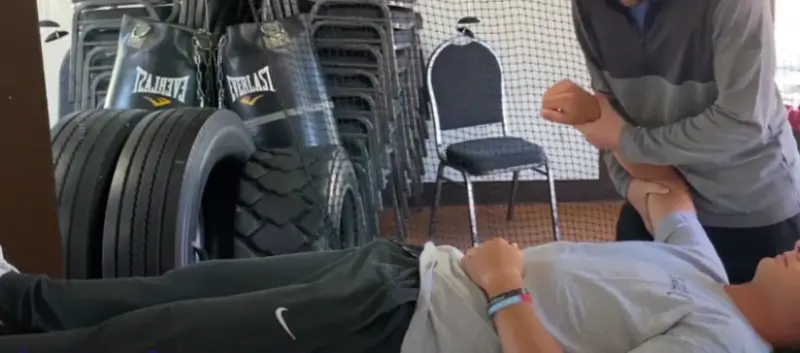Dead arm syndrome, or pitcher’s arm, is characterized by pain or weakness in the upper arm during a throwing movement. This ailment can cause the affected arm to feel limp and stiff, numbness or tingling. Additionally, dead arm syndrome can make your arm feel fatigued.
Waking up with a dead arm can be alarming, especially on a day when you plan to go cycling. A dead arm usually refers to a temporary loss of sensation and strength in the arm, often caused by prolonged pressure on the nerves during sleep.
It’s a natural protective mechanism, and most of the time, it won’t cause lasting damage to the nerves.
This blog will not only explain why dead arms can be dangerous on your cycling day but also provide actionable tips and treatments to manage and prevent this situation.
Is Waking Up With A Dead Arm Dangerous On Cycling Day?

When you wake up with a dead arm on the day you plan to cycle, you risk being uncomfortable and compromising your performance. Here’s why this occurrence can impact your cycling experience:
Impaired Control and Handling
A dead arm, often characterized by numbness, tingling, or weakness, can significantly impair your ability to control and handle your bike. This can increase the risk of accidents, as precise and quick reactions are crucial for navigating turns, avoiding obstacles, and maintaining balance.
Delayed Reaction Time
Numbness or reduced sensation in your arm can slow down your reaction time. Cyclists must be alert and responsive to sudden environmental changes, such as traffic conditions, road debris, or unexpected movements by other cyclists or pedestrians. A delayed response can lead to collisions or falls.
Reduced Braking Efficiency
Cycling often requires quick braking. A dead arm can make applying force on the brake levers difficult, leading to longer stopping distances and potential accidents, especially in emergencies.
Increased Fatigue and Discomfort
Starting your ride with a dead arm can increase fatigue and discomfort. As you ride, the constant effort to compensate for the lack of sensation or strength in your arm can tire you out more quickly, reducing your overall endurance and enjoyment of the ride.
Potential Underlying Health Issues
Waking up with a dead arm could mean you’ve got nerve compression, poor circulation, or other medical conditions. Ignoring these symptoms and continuing to cycle could exacerbate the problem, leading to more severe health complications in the long run.
Repetitive movements
The ligaments in your shoulder can be stretched by repetitive movements, such as throwing or cycling. Ligaments are bands of tissue that connect joints and bones. When the ligaments stretch and become loose, they can cause shoulder pain and instability.
Rotator Cuff Tendons Injured
Dead arm syndrome may occur because of injuries to the rotator cuff tendons. The rotator cuff comprises muscles and tendons that support the upper arm bone, providing stability to the shoulder and enabling a full range of motion.
5 Safety Considerations On Cycling Day When Waking Up With A Dead Arm
Safety considerations are essential when developing a dead arm on Cycling Day to ensure a smooth and enjoyable
experience. Here are some tips to keep in mind:
- Regain Feeling: Before cycling, take a moment to gently shake and move your affected arm to regain feeling and ensure proper blood circulation. This will help prevent any sudden surprises while riding.
- Stretching: Perform gentle stretches to loosen up your arm muscles and increase flexibility. This can help ease any lingering numbness and reduce the risk of cramps during your ride.
- Check Equipment: Ensure your bike works well before heading out. Check the brakes, and gears, and try to avoid any unexpected issues while on the road.
- Hydration: Stay hydrated throughout your ride, especially if you experienced discomfort during the night that may have affected your hydration levels. Carry a water bottle with you to sip on as needed.
- Mindful Riding: Be extra cautious and aware of your surroundings while cycling with a recovering arm. Practice defensive riding techniques, signal your intentions clearly, and stay alert to road hazards.
5 Methods Of Treating Dead Arm Syndrome On Cycling Day
Dead arm syndrome is treated by improving your shoulder’s stability and strength. The best approach depends on how often you do overhead movements and how bad your injury is. Here are some methods to make Dead Arm Syndrome easier and ensure a more comfortable cycling experience on Cycling Day:
Rest
Rest is crucial for recovering the arm affected by Dead Arm Syndrome. Avoid putting excess strain on the arm during cycling or other physical activity that could worsen the condition. Giving the arm time to rest can help reduce inflammation and promote healing.
Physical Therapy
Physical therapy can help with Dead Arm Syndrome. Rehabilitation can be customized by a physical therapist that includes exercises to strengthen the affected arm, improve flexibility, and enhance overall mobility. You can also use physical therapy to fix muscle imbalances or weaknesses contributing to the syndrome.
Ice Therapy

Ice can reduce inflammation, numbness, and pain in Dead Arm Syndrome. Ice therapy involves wrapping ice packs in a towel and applying them to the arm several times a day. This can help constrict blood vessels and ease discomfort.
Anti-Inflammatory Medications
Nonsteroidal anti-inflammatory drugs (NSAIDs) may be recommended for easing pain and inflammation related to Dead Arm Syndrome. These medications can relieve discomfort, swelling, and stiffness in the affected arm. A healthcare professional should be consulted before taking any medication.
Surgery
In severe cases of Dead Arm Syndrome where conservative steps haven’t worked, surgery can be used as a last resort. Surgical interventions such as decompression surgery or nerve release procedures may be performed to relieve pressure on nerves or address underlying issues causing the syndrome. Surgery is usually recommended when other treatments don’t work to provide relief.
4 Prevention Tips For Dead Arm Dangerous On Cycling Day
To prevent the occurrence of Dead Arm Syndrome and ensure a safe cycling experience on Cycling Day, incorporating the following prevention tips into your routine can be beneficial:
Strengthening Exercises
Regular strengthening exercises for your arms, core, upper back, and shoulders are strong by doing strengthening exercises. Shoulders and back muscles can help improve overall muscle endurance and stability. Stronger muscles are better equipped to support your arms during cycling, reducing the likelihood of developing Dead Arm Syndrome.
Use the Right Technique
Proper cycling is essential for preventing strain on your arms and shoulders. Fit your bike to your body proportions, hold the handlebars loosely, and distribute your weight evenly between your arms and legs while riding. Correct techniques can help minimize stress on your arms and reduce the risk of developing arm-related issues.
Change Body Positioning
Periodically changing your body positioning while cycling can help ease pressure on specific muscle groups, including your arms. Shift your posture by adjusting your hand positions on the handlebars, standing up occasionally to stretch your arms and back, and varying your riding position to prevent excessive strain on any one area.
Stretch Regularly

Incorporating stretching exercises into your pre- and post-cycling routine can promote flexibility and reduce muscle tension in your arms and upper body. Focus on stretches that target the arms, shoulders, and neck to maintain an optimal range of motion and prevent stiffness that can contribute to Dead Arm Syndrome.
Conclusion
On a cycling day, a dead arm is more than an inconvenience; it’s potentially dangerous and can dampen your ride. The good news is that you can implement some strategic prevention measures, like maintaining a proper riding technique, changing body positioning during rides, and incorporating strengthening and stretching exercises into your fitness routine.
You can significantly reduce the likelihood of experiencing this. If you wake up on cycling day with a dead arm, consider prioritizing your health, resting, doing some stretches, and, if needed, postponing cycling.
FAQs
Can Waking Up With A Dead Arm Lead To Long-Term Issues For Cyclists?
Waking up with a dead arm occasionally is common and may not cause long-term problems. However, suppose it persists or is accompanied by other symptoms. In that case, it’s advisable to seek professional advice to rule out underlying issues that could affect your cycling performance in the long run.
What Are The Best Ways To Improve Circulation In Arms While Sleeping?
You should avoid laying on your arms under your pillow because this can compress your nerves. Keep your wrists unflexed since flexing can cause tingling. Sleep on your back with your arms overhead, but keep them next to you to reduce nerve pinching. Stretch your hands and wrists before you go to sleep.


